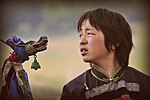 | тавги, tavgi) is a moribund Samoyedic language spoken by the Nganasan people. Nganasan is the most divergent language of the Samoyedic branch of the... 26 KB (1,604 words) - 06:59, 9 April 2024 |
Nganasan may refer to: Nganasan people, an indigenous people of the Russian Far North Nganasan language N. Ganesan (1932–2015), chairman of the Football... 294 bytes (58 words) - 12:30, 21 June 2021 |
 | Samoyedic languages and peoples have been divided into two major areal groups: Northern Samoyedic (Nenets, Yurats, Enets, Nganasans), and Southern Samoyedic... 6 KB (361 words) - 05:13, 15 April 2024 |
 | Shamanism in Siberia (section Nganasan) of Nganasan people enabled that shamanism was a living phenomenon among them even in the beginning of the 20th century, the last notable Nganasan shaman's... 38 KB (3,729 words) - 05:42, 26 April 2024 |
 | Nenets people, also known as Samoyeds, are an indigenous people in northern arctic Russia, and some live at the Taymyr Peninsula. The Nganasan people are... 9 KB (703 words) - 01:48, 15 March 2024 |
the Taimyr Peninsula by the Nganasan people. Before the expansion of universal education in the 20th century, most Nganasan spoke only their own language... 1 KB (66 words) - 02:07, 25 March 2024 |
 | Shamanism (redirect from Shamanism among the Indigenous peoples of the Americas) location of Nganasan people allowed shamanism to be a living phenomenon among them even at the beginning of the 20th century, the last notable Nganasan shaman's... 81 KB (9,338 words) - 10:33, 1 April 2024 |
 | Hungarians (redirect from Magyar people) "Siberian" component associated with Khanty/Mansi, as well as the Nganasan people, and argued to have arrived with the historical Magyars. Modern Hungarians... 112 KB (11,145 words) - 03:42, 18 April 2024 |
 | Genetic studies on Sami (redirect from Population Genetics of the Sami Peoples) originating from a Neo-Siberian source population, best represented by the Nganasan people. The specific Siberian-like ancestry is proposed to have arrived in... 26 KB (3,071 words) - 09:35, 6 January 2024 |
Siberia. U4 is found in the endangered Nganasan people of the Taymyr Peninsula, in the Mansi (16.3%), and in the Ket people (28.9%) of the Yenisei River. It... 84 KB (9,117 words) - 07:59, 11 April 2024 |
 | Seima-Turbino culture (category Uralic peoples) Neolithic/Bronze Age Eastern Siberians, which peaks among Uralic-speaking Nganasan people. They also displayed affinity to Okunevo culture remains, which in... 27 KB (2,864 words) - 15:35, 9 April 2024 |
 | Scythians (redirect from Scythian people) were likely brought by individuals sharing affinities with modern-day Nganasan people, as well as the ancient Okunevo culture. In terms of paternal haplogroups... 277 KB (32,473 words) - 11:38, 13 April 2024 |
 | Ordos culture (redirect from Ordos people) component, which most closely corresponds to the modern North Siberian Nganasan people of the lower Yenisey River, to varying degrees, but generally higher... 38 KB (4,312 words) - 14:03, 20 April 2024 |
 | Nenets (redirect from Samoyed (people)) applied indiscriminately to different peoples of Northern Russia who speak related Uralic languages: Nenets, Nganasans, Enets, Selkups (speakers of Samoyedic... 30 KB (3,596 words) - 23:24, 30 March 2024 |
 | enter their land. Samoyedic peoples include: Northern Samoyedic peoples Nenets Enets Nganasan Southern Samoyedic peoples Selkup Kamasins or Kamas Mator... 47 KB (4,302 words) - 08:02, 27 April 2024 |
 | Scytho-Siberian world (section Peoples) component most closely corresponding to the modern North Siberian Nganasan people of the lower Yenesei. Furthermore, archaeological evidence now tends... 63 KB (7,323 words) - 08:14, 27 April 2024 |
 | Uralic languages (redirect from Uralic people) present only in Nganasan. Vowel harmony is present in the Uralic languages of Siberia only in some marginal archaic varieties: Nganasan, Southern Mansi... 86 KB (7,372 words) - 06:56, 27 April 2024 |
hominine Dolgans Kazakhs (before USSR) Kyrgyz (before USSR) Ket Meenas Nganasan Nicobarese Papuans Penan Raute Sakai Selkup Semang Siberian Yupik Yakuts... 22 KB (1,883 words) - 01:12, 23 February 2024 |












